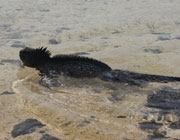Introduction
Marine iguanas are abundant on the coastlines of all the Galapagos islands. There are 7 recognised subspecies and an estimated total population of 250,000. Interestingly, hybrids with land iguanas have been recorded on South Plaza Island.
Identification
Marine iguanas are generally large and dark, but with varied colouration. They can be distinguished from the land iguana by their flattened and fairly squared nose, which has adapted to this shape for the sole purpose of feeding on marine algae. They can also de differentiated from the land iguana by their vertically flattened tail, an adaptation to aid them with swimming. The adult male has a row of long spines which stretches from head to tail. The colouring and patterns vary dependent on the subspecies, ranging from red and black (venustissimus on Española), green, yellow and black (albermarlensis on Isabela) to a predominantly dark and soot-like colour (cristatus on Fernandina). During the mating season, the iguanas' colouring become significantly brighter. The adult female and juveniles are considerably smaller than the adult male and are entirely dark in colour with a ridge of shorter spines along their backs.
The length of marine iguanas varies considerably, depending on the subspecies. The individuals on Isabela, Santa Cruz and Fernandina are the largest, while those found on Genovesa and Española are the smallest. Furthermore, the hatchlings from these smaller marine iguanas are not dissimilar in size to those of lava lizards.
Behaviour Photographs kindly provided by Ralph Pannell & Anele Waters
Maine iguanas can most commonly be seen along rocky shorelines, with females and juveniles often observed basking in the sun together in large groups. They can often be seen climbing trees or cacti to their favoured sunbathing spot. Galapagos marine iguanas are the only marine lizard in the world to feed off of algae obtained from either the splash zone or through diving. They can spend up to an hour underwater. They are extremely territorial iguanas, particularly during the breeding season. The male shakes his head rapidly up and down and exhales rather loudly to demonstrate his agitation if disturbed. Males will take up to 8 years to become sexually mature.
The Beagle - Mary Anne - Cachalote - Sagitta - Amazonia - Samba - Beluga - Galaxy - Princess Grace - Aida Maria - Eden - Evolution - Eclipse - Grand Odyssey - Journey I - Eric - Flamingo - Letty - Odyssey - Athala - Nemo I - Nemo II - Diamante - Alta - Lammer Law - Rachel - La Pinta - Humboldt Explorer - Parranda - Isabela (Albemarie) - Santa Cruz (Indefatigable) - San Cristobal (Chatham) - Baltra (South Seymour) - North Seymour (Seymour Norte) - Fernandina (Narborough) - Española (Hood) - Genovesa (Tower) - Bartolomé (Bartolemew) - Santiago (San Salvador or James) - Santa María (Floreana or Charles) - Marchena (Blindoe) - Mosquera - Plaza Sur (South Plaza) - Pinta (Abingdon) - Pinzón (Duncan) - Santa Fé (Barrington) - Rabida (Jervis) - Daphne
Galapagos wildlife birdlife birdwatching & natural history holidays - Sail Galapagos islands - expedition cruise vacation holiday - Ecuador responsible travel - Amazon - Andes - Quito - Guayaquil - sky aggressor - Dive Snorkel Diving & Snorkelling - kayak westsuit - Latin & South America journey - Specialist Guided Photography holidays workshops - Charles Darwin Research Station - Galapagos Conservation Trust - Rainforest Concern






